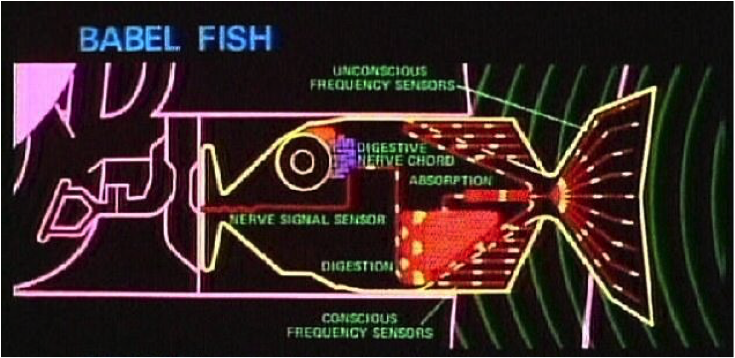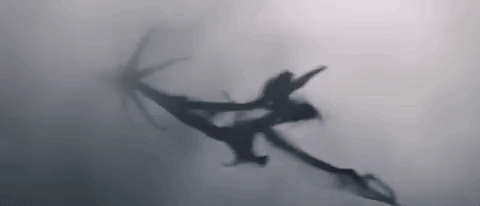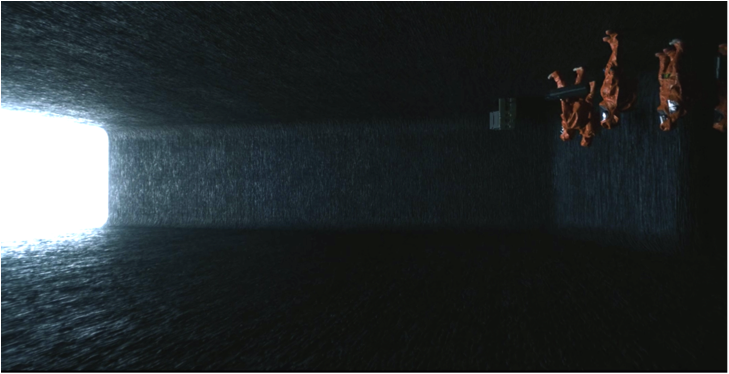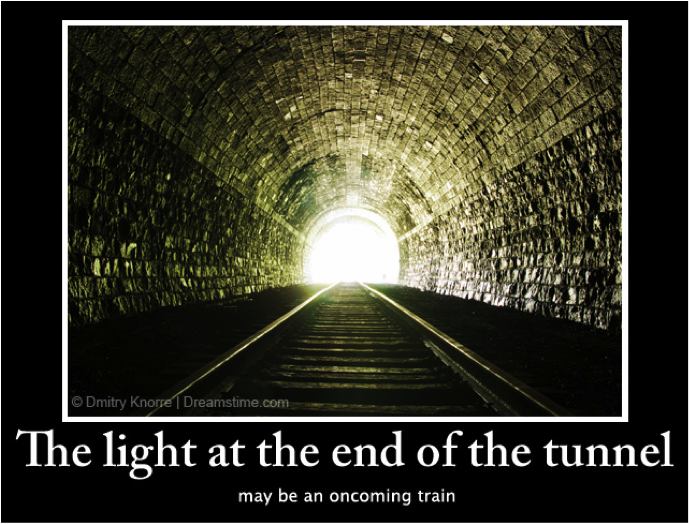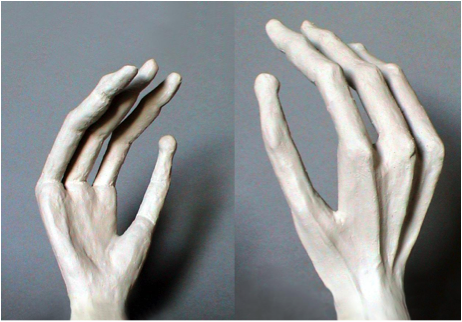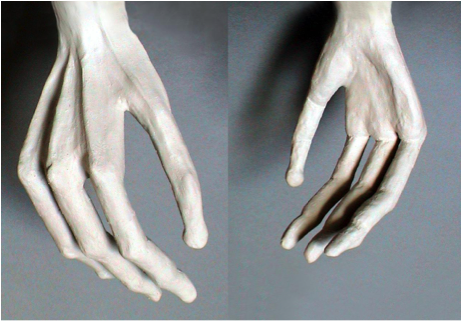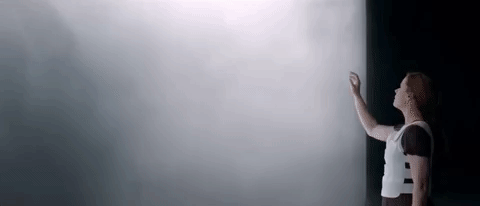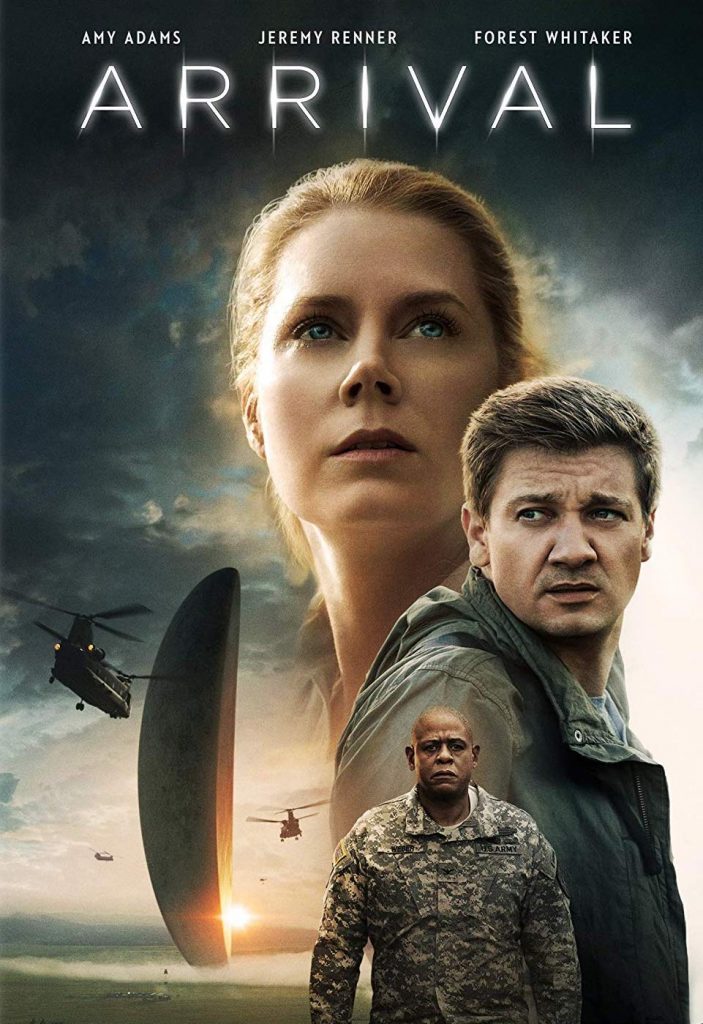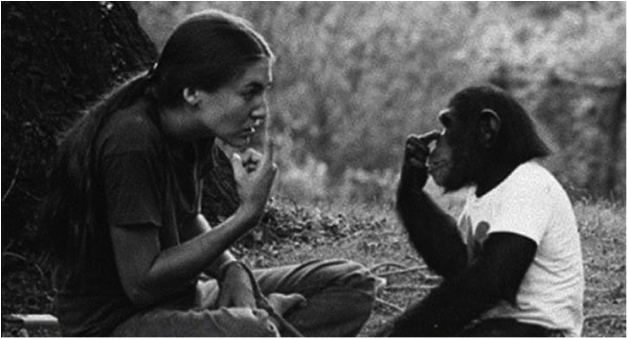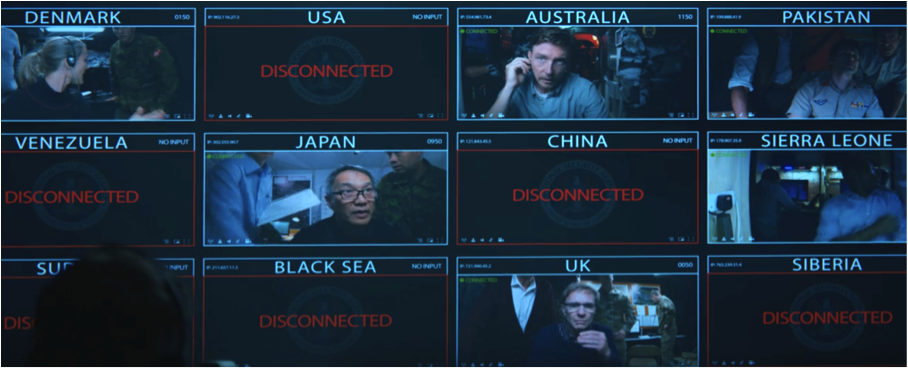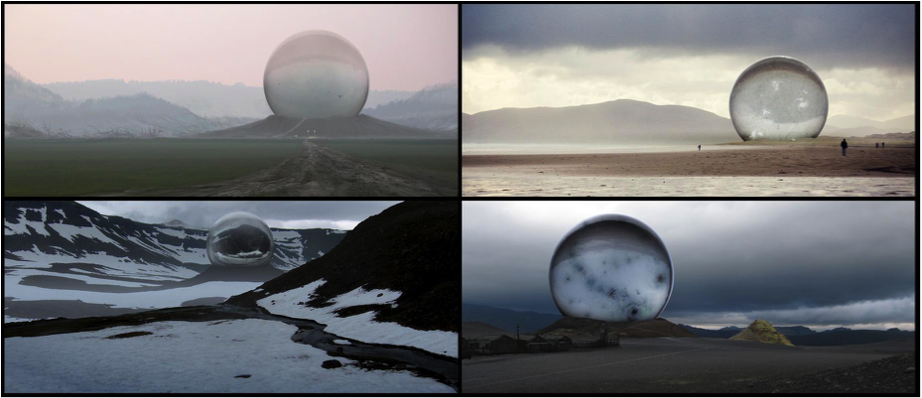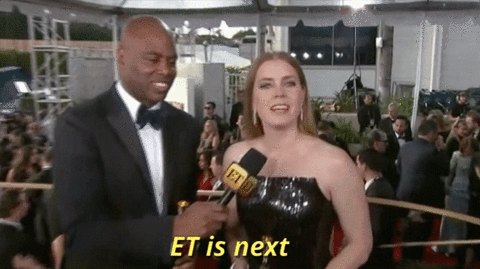When I think of science fiction films, I immediately think of two things: aliens and explosions. Arrival plays with these expectations of the genre, asking the viewer to look at aliens in a way they’re not used to. Taking Villeneuve’s vision of the alien to be a non-human creature, it is appropriate to categorise the aliens in Arrival as other-worldly animals. Based on Ted Chiang’s novella Story of Your Life, Arrival follows Louise Banks (Amy Adams), a linguistic professor recruited to lead an investigation into the language of aliens that have landed in twelve spaceships across the globe. She soon discovers that the aliens are highly intelligent animals, which they name Heptapods, and that their language has ‘no forward or backward direction’. As she begins to comprehend the language, she starts to have flashbacks of her daughter, Hannah. Through the complex treatment of time in the film, these visions – assumed by the audience to be flashbacks – are revealed to be flash-forwards, as Louise can see her own future now that she understands the language of the Heptapods. She uses her knowledge of the future to prevent world panic and destruction, reuniting countries that have ceased to communicate and ‘saving the day’ in typical generic style.
Arrival both satisfies and complicates the narrative expectations of the science fiction genre. The film is removed from reality through the presence of aliens, but attempts to maintain a relative level of realism in its storytelling. There are no climactic fight scenes, or battles between good and evil, rivalling the likes of Marvell’s X-Men: Apocalypse and Captain America: Civil War, which were also released in 2016, but this by no means removes the film’s tension. The only violence is created by human characters, allowing the film to reflect on what it is to be human, rather than what it is to experience an elaborate alien encounter. This reflection is only able to come about in the presence of an animal; while thinking about the ‘Other’, the film points towards the human. The human/animal relationship in the film is used to humble the human characters, as they realise that the Heptapods are superior to them in language, but at the same time it uses the fictionality of ‘aliens’ to reinscribe human dominance. The Heptapods challenge the assumption that language separates humans from animals. This challenge is inevitably shut down by the fact that the film is necessarily unreal, reinstating human value.
Communication
In this exploration of language, the film rejects the convenience of a shared language between humans and aliens, which is famously used in Hitchhiker’s Guide to the Galaxy through the use of a ‘babel fish’ and the Tardis in Doctor Who. The firm language barrier between the two species manifests in the glass wall separating the humans from the Heptapods. The film also transforms the figure of the ‘alien’ beyond the screeching, nonsensical animal (e.g. Godzilla), finding a middle ground that has seldom been explored in films of this genre, carefully balanced between mysterious silence and intelligent communication.
The human characters begin their exploration of the spaceship wearing protective clothing; the bright orange exteriors of these ‘space suits’ give the humans an almost alien appearance. Their faces are barely visible and the distortion of gravity in the ship causes their movements to be awkward and ‘inhuman’. Overlapping ideas of the human-alien and the alien-human are repeatedly explored within the bizarrely dislocated space of the ship.This overlap is complex: if we disregard alleged ‘sightings’, then the stereotypical idea of the alien stems entirely from the human imagination. By distorting the idea of the human in the presence of the alien/animal, the film starts to question the stability of human dominance.
When the human characters first enter, they appear to walk across the ceiling of the ship in a long shot, confusing the viewer’s understanding of physical space within the alien sphere. The concept of time, which surrounds the exploration of the Heptapods, is introduced to the mise-en-scene before the aliens are seen for the first time. Within the ship, the human side of the barrier is dark and closed in. This contrasts the light of the alien space beyond the glass. The tunnelling effect creates obvious ‘light at the end of the tunnel’ symbolism, reflecting humans’ linear approach to life (tunnel) and death (light). Louise subsequently learns to reject this time-centric philosophy, as she progresses through the events of the film.
Appearance
While the appearance of aliens varies from film to film, they are typically portrayed as relatively humanoid, particularly in the Spielberg classics E.T. and Close Encounters of the Third Kind. Instead, the Heptapods’ bodies seem to resemble large hands. They have seven legs (hence the ‘hept’ in Heptapod) and long, dark bodies that fade into the mist above them, giving them a mysterious edge, as their full form is not visible or certain. Their legs resemble fingers, which is complemented by the attention the camera pays to hands throughout the first interactions between the humans and animals in the meeting scene. Their appearance is not humanoid, which aligns them more with an animal presence than a human one, yet their intelligence far surpasses that of humans, making them superior while also inherently animalistic.
The physical shape of the Heptapods and their lack of visible facial features gives them a menacing presence during their first scene. Usual interactions between humans and animals focus on connections made through the exchange of ‘seeing’. The animal gaze and the looks they exchange with humans are seen by Jonathan Burt as ‘the basis of a social contract […] in the absence of the possibility of language’.[1] Arrival distorts this idea, giving the animals language without the recognition and ‘social contract’ of seeing. The viewer has to learn to trust and respect the aliens without establishing a conventional connection through speech or sight. The Heptapods’ lack of facial features is a conscious artistic decision, and one which removes the ability to automatically forge a normal relationship between characters. This inaccessibility builds on the idea of the Heptapods’ superiority, adding to the distance between them and the human characters.
In place of this exchange of ‘seeing’, an emotional connection between the two species is forged through the use of hands. Not only do the Heptapods strangely resemble hands, but their own tentacle-like hands are used to write and communicate with humans. When Louise first hears a clip of the sound the Heptapods make, she asks:
Louise: ‘How many?’
Colonel: ‘How many what?’
Louise: ‘How many… err… speaking? Did they have… mouths?’
Without mouths or other facial features, it is difficult to establish a connection. Louise also struggles with what to call them, faltering rather than calling them aliens or animals, exemplifying how humans struggle with the unknown. She presses her hand to the glass and the Heptapod mirrors this action in what she labels ‘a proper introduction’. Communication through hands is frequently found in human/animal relations, particularly with chimpanzees being able to learn sign language and dogs learning commands through their master’s actions. The silent language of hands establishes communication between Louise and the Heptapods, creating a relationship between the human and the animal, which reveals the aliens’ willingness to communicate non-violently.
The ‘Other’
The film is consciously concerned with how humans instinctively treat animals, and what happens when those animals are more advanced than supposedly ‘superior’ humans. It is human language that is less advanced in the film, and the acceptance of this fact is what causes much of the film’s friction; humans do not trust the animalistic ‘otherness’ of the Heptapods, or their apparent greater intellect. The connection established between Louise and the Heptapods begins to bridge the gap between the human and animal. However, the more that is discovered about the Heptapods’ intelligence, the more the other characters in the film view them as a threat: their superiority is dangerous.
The Heptapods are never violent, but the human characters are always wary that they may be at any moment. Their complete separation from anything recognisably human, or familiarly animal, gives them a fearful quality that brings to mind Freud’s ‘Uncanny’.[3] World leaders become suspicious of the aliens’ motives, particularly when they respond to the question: ‘What is your purpose here on Earth?’ with the word ‘Weapon’. This scene sparks issues about the role of language and how easily it is misinterpreted, as it is later discovered that the Heptapods meant to say the word ‘tool’. It is this moment that causes countries to stop sharing information with each other; the threat of violence pushes people to reject the unknown ‘Other’, which is both the aliens and humans from different countries. The Heptapods’ non-violence is present even in the film’s title: they ‘arrive’ rather than invade. It is not their violence that proves to be the greatest threat to human life, but their apparent superiority to humans.
The presence of the unknown undermines the established hierarchy that divides humans from animals. The Heptapods surpass humans in their intelligence, but are treated as separate from humans as if they are animals, which questions the underlying relationships between the human and animal. During one of the the flash-forward scenes, Hannah is drawing a picture of a Heptapod with her parents and saying ‘Mommy and Daddy talk to animals’. Louise’s future translations of their language allow the Heptapods to be seen as ‘animals’ rather than ‘aliens’. The alien was unknown; the animal is known. Balance is restored at the end of the film, but only through the Heptapods’ departure. They pose too great a threat to the dominant position of humanity for them to remain on Earth, and so the world of the film returns to relative normality, reinstating humans as the highest life form.
Conclusion
Arrival explores human/animal relations in terms of human dominance. The human characters surrounding Louise immediately feel threatened by the Heptapods, preparing for violence rather than peace. The fear of invasion by the ‘Other’ is returned to again and again in films of all genres, whether the ‘Other’ is human or animal. Arrival plays with this idea of invasion to briefly undermine the human position, safe in the knowledge that as soon as the viewer leaves the cinema their sense of humanity’s place in the world will be quickly restored. The science fiction genre, and the presence of aliens rather than earthly animals, allows it to question the position of humans in relation to animals, without ultimately doubting human superiority. The genre creates a space in which reality is suspended so that these abstract ideas can be explored without mortally wounding the human ego. The shape of the Heptapods aids this suspension of disbelief, removing them from any kind of recognisable animal, while also setting them apart from the human.
The film uses the science fiction genre as a way of exploring communication barriers, between humans and animals, as well as humans and other humans. It is only through the interactions between Louise and the Heptapods that her relationships with other characters in the film are able to develop. The Heptapods’ language and the story’s focus on this ‘Other’ act as allegories for the complexity of our own language and the way that humans relate to each other. Through utilising an extraterrestrial threat in the invasion narrative, the film breaks down the barriers between people of different nationalities. The plot’s triumph is that the world learns – even if only at the last minute – to work together rather than always assuming the ‘Other’ is a danger and a threat. Human superiority is reestablished at the film’s end, encompassing all humans, not just the white Americans that dominate the majority of the screen time.
The non-violent, slow-paced nature of Arrival sets it apart from the current climate of action-packed blockbusters. It is part of a more thoughtful type of science fiction film, joining the likes of Christopher Nolan’s Interstellar in exploring the human perception of time. Human dominance is ultimately reaffirmed, but through the film’s questioning of its stability, it is able to give fresh life to wonderings about human existence.
[1] Jonathan Burt, Animals in Film, (London: Reaktion, 2002) p.39.
[2] Benedict Carey, ‘Washoe, a Chimp of Many Words, Dies at 42’, New York Times, 1st November 2007, https://www.nytimes.com/2007/11/01/science/01chimp.html [accessed 18.12.2018]
[3] Sigmund Freud, The Uncanny, trans. by David McLintock (London: Penguin, 2003).
Bibliography:
Burt, Jonathan, Animals in Film, (London: Reaktion, 2002).
Carey, Benedict ,‘Washoe, a Chimp of Many Words, Dies at 42’, New York Times, 1st November 2007, https://www.nytimes.com/2007/11/01/science/01chimp.html [accessed 18.12.2018]
Freud, Sigmund, The Uncanny, trans. by David McLintock (London: Penguin, 2003).
Further Reading List:
Evnine, Simon, ‘“But is it Science Fiction?”: Science Fiction and the Theory of Genre’, Midwest Studies In Philosophy, 39.1, (2015) pp.1-28.
https://onlinelibrary.wiley.com/doi/epdf/10.1111/misp.12037 [accessed 12.12.2018]
Carruthers, Anne, ‘Temporality, Reproduction and the Not-Yet in Denis Villeneuve’s Arrival’, Film Philosophy, 22.3, (2018) pp. 321–339.
https://www.euppublishing.com/doi/pdfplus/10.3366/film.2018.0083 [accessed 18.12.2018]
Flemming, David, ‘Through a (First) Contact Lens Darkly: Arrival, Unreal Time and Chthulucinema’, Film Philosophy, 22.3 (2018) pp.340–363.
https://www.euppublishing.com/doi/pdfplus/10.3366/film.2018.0084 [accessed 19.12.2018]
Arrival: a response to bad movies: https://www.youtube.com/watch?v=z18LY6NME1s [accessed 19.12.2018]
Interstellar, dir. by Christopher Nolan (Paramount Pictures, 2014).
E.T. The Extra-Terrestrial , dir. by Steven Spielberg (Universal Pictures, 1982).
Close Encounters of the Third Kind, dir. by Steven Spielberg (Columbia Pictures Corporation, 1977).
Godzilla, dir. by Gareth Edwards (Warner Bros., 2014).
The Hitchhiker’s Guide to the Galaxy, dir. by Garth Jennings (Buena Vista Pictures, 2005).
X-Men: Apocalypse, dir. by Bryan Singer (20th Century Fox, 2016).
Captain America: Civil War, dir. by Anthony Russo, Joe Russo (Walt Disney Studios Motion Pictures, 2016).

